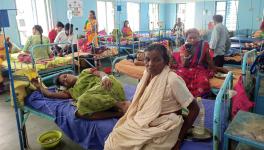Trade Union Report Flags Mental Health Impact of Working in Public Healthcare

Public Services International (PSI) recently launched a new report examining the mental health of health workers in Liberia, Brazil, Sweden, Australia, and Canada. While significant differences persist between health systems in the Global South and the Global North, many problems are shared, including long working hours, high work demands, and low wages, as well as precarity.
People’s Health Dispatch spoke to two co-authors of the report, “Mental Health and Public Sector Healthcare: International Case Studies,” Ruth Ballardie and Vera Weghmann, to learn more about the key messages emerging from the analysis.
People’s Health Dispatch (PHD): Health workers’ own mental health has been a back-burner issue for a long time. Can you explain the links between work and health care workers’ mental health about how cuts to public health care budgets have shaped this?
Ruth Ballardie (RB): Globally, mental health of healthcare workers has been deteriorating for many years. Alongside this, we have seen increases in work-related stress. Work-related stress has increased globally from 33% of workers reporting some form of work-related stress in 1990 to 44% reporting work-related stress in 2022. The COVID-19 pandemic then greatly exacerbated work-related stress and mental health. The increase has been happening across many occupations, but it’s been the worst for healthcare workers.
To understand the decline in healthcare workers’ mental health, we need to examine changes in their work environment. Addressing mental health issues requires more than band aid solutions; we need to look at what is happening at the collective level, in the work environment. The connection between work-related stress and the working environment is critical, especially the role of psychosocial risks.
These risks, which have been on the rise, include factors like excessive workloads, high work pressure, understaffing, long hours, poor communication, low levels of social support, and inadequate professional development, leading to mental and physical health problems such as depression, anxiety, burnout, PTSD, cardiovascular diseases, and musculoskeletal disorders. Psychosocial risks occur because of the working conditions of healthcare workers. They’re also exacerbated by issues such as low pay and job insecurity. And with the healthcare workforce being predominantly female, gender inequalities also play a role.
For example, low pay makes it difficult to retain staff or to encourage professional development, which is often paid by the worker. This makes nurses, for example, less likely to take on specialist training – we found this to be particularly the case in Sweden where the pay difference between regular nurses and specialist nurses is low, making undertaking specialist training not economically attractive.
Then, there’s the problem of high staff turnovers with difficulties retaining staff as well as recruiting new workers into an overburdened workforce. Insufficient staff adds to the burden on the existing staff because their workloads become even higher, leading to less people wanting to enter the healthcare workforce and further affecting retention rates. For example, in the Australian case, we had highly educated new graduate midwives leaving the field because they were finding the workloads too high and this was compromising the potential risks to patients and their confidence in being able to deliver safe care. So these psychosocial risks create negative feedback loops that exacerbate the problems and affect the quality of patient care.
PHD: Why did these factors deteriorate so much?
RB: To answer that question, we have to consider another one: why has the work environment deteriorated over the last few decades for healthcare workers? This means we have to start looking at the macro level factors that have been underpinning this.
Over the past 40 years, there’s been an introduction of neoliberal policies and economics and funding models which has led to the underfunding of healthcare. Alongside this has been anti-trade union legislation, which has inhibited the capacity of unions to take action on these issues. At the international level, you’ve had international organizations like the World Bank and the IMF limiting the funding of public services within low and middle-income countries.
What this has led to is recognized by all funding bodies as a global healthcare workforce crisis. While there are similar psychosocial risks across all national healthcare systems, such as high workloads and retention problems, the way that these interact with macro level drivers can only be understood when you take a country by country examination of the specific social, economic and political situations and their historical development.
So to understand the causality at a national level, you need to look at what has been happening specifically in these countries over a period of time. And this is what we have done in this study.
The underpinning driver of the changes in all of these countries is the ways in which neoliberal policies were implemented and the degree to which unions have been able to fight back.
In particular, there’s been insufficient national and regional investment in adequate staffing levels, in ensuring there’s an adequate skill mix, in the training of new graduates and key medical specialties, and in their professional development. There has been insufficient investment in managerial support of healthcare workers and in maintaining adequate wages to recruit, retrain and develop staff.
There’s also issues with workplace bullying, harassment and violence, which is also linked to the underfunding of healthcare systems.
And then there are issues around the legislation in terms of occupational health and safety that specifically address psychosocial risks and that ensure workplaces are safe and that they provide decent working conditions. For healthcare in some countries such as Brazil, the issue of precarity and job insecurity also plays a major role.
PHD: One part of the report looks at what happens when this situation is exacerbated by the COVID-19 pandemic. Could you elaborate on that?
RB: It needs to be very clear that the global health care crisis existed well before COVID-19. What COVID-19 did was highlight the issues: the underfunding, the lack of preparedness of national health care systems, and it exacerbated the problems for health care workers. All workers in Europe were exposed to higher levels of psychosocial risk during the pandemic. Work-overload, for example, jumped from 5% to 46% during COVID-19. Perceived lack of autonomy or influence over work went from 1.4% to 18%, and harassment and bullying jumped from 0.8% to 7%.
Healthcare workers were at the forefront of the epidemic and they confronted even worse situations. They were dealing with unprecedented demands within a system already depleted of the workforce, and things were made even worse by the fact that so many workers had to call in sick themselves. Rates of burnout, fatigue, emotional exhaustion, and PTSD arose significantly during COVID-19 amongst healthcare workers.
These effects of COVID-19 haven’t gone away because people have gone back to work and we’re not wearing masks anymore. They are still here for the healthcare workers, who still have COVID-19 patients to treat. And then there’s the backlog of patients needing treatment that accumulated during the pandemic, which puts even further pressure on health systems and healthcare workers.
PHD: Have you recorded any attempts to address the issues caused by the global health workforce shortage?
RB: One of the ways in which high income countries have attempted to address this is by engaging in aggressive recruitment of healthcare workers overseas, primarily from low- and-middle-income countries, rather than sufficiently investing in their own healthcare systems. The World Health Organization (WHO) has registered a worsening effect of this on healthcare in low-income countries: they designated 55 countries as vulnerable to the repercussions of aggressive international recruitment of health workers on their healthcare systems.
The WHO advised that if there is recruitment from low and middle income countries, then there have to be reciprocal benefits paid by the recruiting host country to the donor countries. There need to be reciprocal benefits, for example funds to invest in the healthcare education and training systems.
PHD: That’s an important point also because the report shows that the effects of the mental health crisis among health workers are unequal if we talk about high income and low-income countries.
RB: Each of the countries that we looked into has a different political history, a different economic and social situation. If you take the case of Sweden, which is a high-income country, you see that it has been at the forefront of research and legislation around psychosocial risks in the workplace. Sweden exemplifies a very high-income, coordinated market economy with a strong tradition of social dialogue and cooperation.
They have some of the strongest occupational health and safety laws and regulatory bodies globally. They also have specific health and safety organizations, like the Swedish Work Environment Agency, that specifically look at the work environment and the psychosocial risks of work. At the time when it was well funded, this agency did some really interesting work on how financial models and the organization of work in healthcare is very gendered and has different impacts on women and men. They did some really fundamental research looking at how funding models and the gendered nature of funding models impacted the healthcare workforce.
Nevertheless, there have been decades of neoliberal policies in Sweden, that have diminished the healthcare system and have led to healthcare workforce shortages. This has increased work related stress amongst healthcare workers, to the extent that it’s difficult to retain them.
They have problems with understaffing, they have problems with poor skill mix, they have problems with not enough nurses in specialized nursing roles, such as mental health, and they have problems with low wages and precarity in long term care, which is exacerbating recruitment problems. So despite having a high income and a tradition of social dialogue, there is a health care crisis in Sweden.
A recent trade union survey of workers in healthcare showed that up to 50% of workers have thought about changing professions or leaving health care altogether, and 61% of these are aged 30 to 49. The primary reason they were quoting for leaving the profession was poor pay and poor work environments.
This is again due to the underfunding and under-resourcing of the healthcare system and the limitations placed on trade unions campaigning around this. You find in Sweden that sometimes the employers just ignore the health and safety regulations concerning psychosocial risks. Even if there are sanctions involved, they’d rather pay the sanctions than comply with the legislation.
In terms of collective bargaining, there’s no provision in the collective bargaining of the healthcare workers’ unions for addressing psychosocial risks. They can look at working time and general working conditions and how they’re regulated, but it would be a very different thing to be able to use collective agreements to address psychosocial risks.
Vera Weghmann (VW): If I had to single out one main takeaway from the report, then it’s that we are facing a global healthcare workforce crisis. To highlight just one figure – the WHO estimated that by 2030, we will face a shortage of 18 million healthcare workers. What is going on has a lot to do with neoliberal policies and privatizations, like Ruth already said. It’s a negative loop that we see in many places: there is a staff crisis which leads to more burnout because there’s too much work, the burnout leads to even more staff leaving, impacting the staff-patient ratio and making the shortage worse.
The global scramble for health workers makes things worse. High-income countries are trying to recruit healthcare workers from the Global South, with tangible effects. Liberia, one of the countries covered by the report, is a country with very few healthcare workers. There’s one doctor for 2000 people and one nurse for 1000 people.
Nonetheless, around half the workers leave the country to work abroad after completing their training. So it’s a really systematic trend that we are seeing of workers from the Global South migrating towards the Global North.
PHD: What other difficulties do health workers in Liberia face when compared to those in Sweden and other high-income countries?
VW: We are seeing a lot coming from international financial institutions like the International Monetary Fund (IMF). Liberia has really felt the effects of IMF-imposed policies. The IMF imposed a freeze on government spending, which means they cannot address the staff shortage because the government is not able to employ more people, which further incentivizes attempts to privatize the sector.
Of course, Sweden and Liberia are two very different countries. Liberia has gone through many, many years of civil war, and this is another big burden. It also faced the Ebola crisis: it actually mounted a pretty quick response to COVID-19 because of the lessons learned during the Ebola outbreak. This includes the mobilizing of volunteers in the health sector, which I guess one can take as both a positive and negative thing. It seems that out of each 10 healthcare workers in Liberia today, 7 are unpaid. The system is really relying on unpaid labor of people who are hoping to get a job at one point in the healthcare sector.
Liberia also doesn’t have the social bargaining system Sweden has. The National Health Workers of Liberia Union is a relatively newly organized union, and unfortunately they’ve seen quite a lot of trade-union victimization for their work. Some of the trade union leaders even had to go into exile because the situation was no longer safe for them in Liberia.
Despite all this, the workers really voted with their feet on a number of occasions and in 2016, 6,000 healthcare workers went on strike, including volunteers. They were protesting burnout levels, but also the fact that they are not able to treat patients because of the lack of staff, of the lack of necessary equipment. If you’re seeing many of your patients die because you’re forced to take care of 50 at the same time, the mental stress is unimaginable. This is really taking a toll on healthcare workers, adding to the mental health burden in a country which already suffers from trauma due to the civil war it faced.
PHD: Yet another case is Brazil. In the report, you say that Brazil is specific because it illustrates the extent to which inequities can impact health workers in different ways. Can you explain what you mean when you say that?
VW: What we see in Brazil is that the situation in the healthcare sector is sharpening the existing inequalities. Mental health is racially impacted, as well as impacted by class. It’s worse for people who are poor and for those who are Black. It’s also worse for women, who make most of the nursing workforce in Brazil, just like in many other countries.
What happens in Brazil is that the shifts are very, very long. There are excessive working hours. I interviewed a nurse for this report, a spokesperson from the nurses’ union, and she told me that it’s very common to see shift patterns of 24 hours. She also said that people often work two shifts in a row because they’re forced to work two jobs in order to make end’s meet.
That means nurses often work 70 to 80 hours a week. It also means that they basically don’t sleep because they roll over from one job into the next and work 48 hours in a row. That is obviously not sustainable and because of this pattern, there are again less nurses.
Brazil is also interested because of the Unified Health System (SUS), which has been eroded by privatization and neoliberal policies up until the end of the Bolsonaro government, especially with the labor reform which has undermined workers’ rights generally. Because of denialism during COVID-19, health risks for health workers were huge, and it left a mark. It’s a really frightening case study where you see how mental health and health in general intersects with class, race, and gender.
RB: I think the important thing to highlight here is how the Bolsonaro government, and the government that preceded him, eroded the capacity of trade unions to act collectively, and this has increased inequality in Brazil. The government drastically cut wages, and thus they created an army of precarious workers.
With the Lula government there’s been change: he’s more supportive of unions, so there has been some effective action around getting a minimum wage for nurses. But again, many of these changes depend on the Supreme Court and other courts in Brazil, so you’ve still got the elites pushing back.
VW: The point that the nurses have been organizing on a national scale in Brazil is a really important one. Through that campaign, they were able to secure a national minimum wage for nurses, which is higher than the national minimum wage. By doing that, they weren’t just fighting for themselves, they were also fighting for the other workers in Brazil by saying that the current minimum wage is too low.
But even in such a context, where it’s clear that there’s a shortage of nurses in Brazil, we’ve seen aggressive recruitment taking place. Germany, for example, has been actively recruiting nurses in Brazil, as have Canada and Portugal. At the same time, Brazil itself is recruiting nurses for lower pay from other Latin American countries. It’s like a chain reaction.
PHD: As a conclusion, based on the things that you’ve elaborated upon in the report, what kind of recommendations would you make to ensure better mental health among health workers and stronger health workforce policies?
RB: There’s three levels at which the recommendations operate. There is the macro level, where you have to challenge the neoliberal consensus. This involves campaigns to fight privatization and to increase public spending in public healthcare. It should also involve campaigns to address agencies like the World Bank, the IMF, and their negative impact on the social care systems in low- and middle-income countries.
There are also international agencies trying to provide guidelines to protect health workers from the negative impacts of what we’ve talked about today, like the International Labor Organization (ILO). The ILO has been working quite actively in the area of global recruitment. So, it’s important to work with the ILO on addressing these aggressive strategies of recruitment of health care workers from low and middle income countries.
There needs to be action on wages and job insecurity in the healthcare sector, as well as action on safe staffing levels. The Australian case study in our report provides a very good case for the achievement of mandated nurse to patient ratios. It illustrates the link between psychosocial risks, staffing levels, and safe patient care. Health workers in Australia were able to use this link in a 10-year campaign to achieve government mandated staffing levels of one nurse to four patients.
Then, obviously there are things like increasing the number of training places and support for trainees. And then there’s the issue of occupational health and safety legislation. As I’ve said, many countries do not have any policies addressing psychosocial risks among health workers or if they have them, their scope needs to be expanded. The role of regulatory agencies could be supported and perhaps include the possibility of introducing sanctions on employers who try to avoid legislation.
But primarily, the Australian case study showed the value of having trade unions involved in training for health and safety officers, and in being able to issue stop work notices in relation to psychosocial risk. In that case, you’re not totally dependent on the regulatory body to protect workers’ mental health.
People’s Health Dispatch is a fortnightly bulletin published by the People’s Health Movement and Peoples Dispatch. For more articles and to subscribe to People’s Health Dispatch, click here.
Get the latest reports & analysis with people's perspective on Protests, movements & deep analytical videos, discussions of the current affairs in your Telegram app. Subscribe to NewsClick's Telegram channel & get Real-Time updates on stories, as they get published on our website.
























